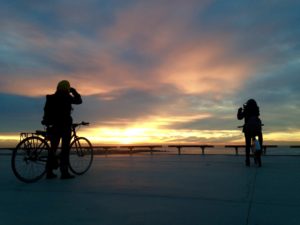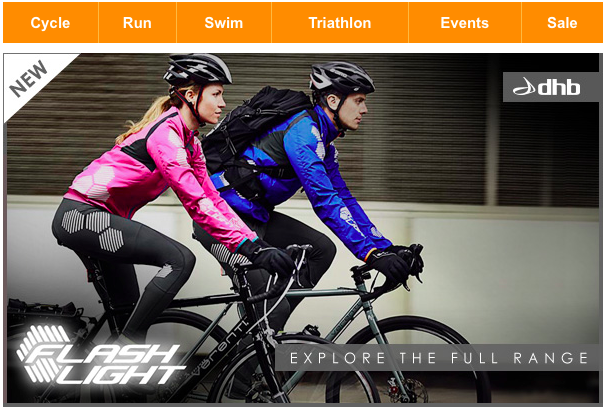Just as everyone was going to bed last night, my friend Wallie and I were unloading our bikes, ready for a ride through the night around the Salisbury Plain area. Most people think I’m mad for doing this kind of thing but actually it’s kind of fun and something a little different. For eagle eyed readers, we did something like this about a year ago and because we enjoyed that so much, we decided to do it again this year. Click here for 2010 link.
The original plan was to ride through the night and then marvel at the sun rising. Instead we had the issue of continuous rain with no improvement being forecast. We were tempted to postpone it but decided to have a shorter ride instead. We’ll have another go on a clear night while we’re still in the mid summer period, all being well.
What’s different about riding at night?
The quick answer is loads of things. I find the way I sense things will become different at night time. Have you ever noticed those pockets of cold, damp air when you’re riding through the countryside at night? Sometimes you’ll hit them in a dip, or perhaps in a wooded area. All very atmospheric, perhaps spooky. That also applies to the mist you’ll sometimes encounter and then there’s the scents you can smell – wow! Both of us last night were struck by the beautiful smell of pine as we rode through a wooded area. Sounds are different, as are glimpses of wildlife.
You can’t see the gradient in front of you so easily, so suddenly you find yourself speeding up or slowing down but the road looks flat. Of course it isn’t but you just can’t see it, but you can feel it.
Other times when we’ve had more visibility, the landscape takes on a different quality that can be very beautiful.
Riding with a friend also brings a certain camaraderie and pleasure in sharing the experience. Sometimes we’d go a mile or two without chatting, just riding alongside each other savouring the ride. We are fortunate with our natural pace being virtually the same, so we’re very comfortable riding with each other – this really helps.
Isn’t it dangerous?
No not at all, providing you take a few precautions and take care. By that I mean having some decent lights, which is obvious really. That’s lights to see the road ahead and to be seen by other traffic you might come across. Don’t forget riding on dry tarmac will bounce far more light back than compared to wet roads. LED lights these days are pretty bright and they have the advantage of not having a bulb to blow in the normal way. Batteries last a lot longer as well. Wallie, as I have come to know over the years, has a keen eye on being thrifty at times but sometimes this doesn’t pay off. He’s lost 2 el-cheapo rear LED lights because of flimsy brackets. So it’s really important to get good lights which fit the bike well. We both had head torches, though mine only came out later when I had a bike problem (see further below). Again these are available with traditional bulbs or LEDs.
Worth considering whether you prefer to blend in or stand out with your clothing – both have their advantages…..
We found there were only a handful of cars around and those were easy to see coming because of their headlight beams shining from a mile away. That gives a feeling of security in knowing there’s no nasty surprises and allows you time to go single file (and for me, to get on the correct side of the road).
Hazards include wild animals. Last year we had the odd startled badger run out in front of us. Country lanes will inevitably have pot holes and these can be difficult to see in time, especially if you’re blasting down a hill. Another country lane hazard is gravel on downhill stretches (this is my worst) which can so easily cause a skid – a front wheel skid is almost impossible to control. When you’re going fast downhill, allow some distance and don’t be blinded or dazzled by the rear light in front of you.
Other times it helps to just have some kind of understanding or communication about who goes first or hangs back when you’re not riding alongside each other. For us, this just seems to happen with the minimum of words.
“Wouldn’t it be a shame if we had a puncture on a night like this?”
Yes, Wallie, it would. It’s just as well I’m not superstitious because no sooner had Wallie said that, a few yards on I felt my back wheel go over a bump differently. And then another and then there’s a continuous vibration. I had a puncture.
Bloody Panaracer Tourguard tyres! Shysters! Is this bad luck or the norm? This means I get one puncture every 350 miles nowadays. This is not good.
Getting it changed was fairly straightforward but interesting to note that out of the handful of cars that went passed, no body stopped to ask if we were okay. The nearest we got to that was a Police car slowing down for a look and then carrying on, presumably we didn’t look too dodgy. Times like this are a reminder of why it is vital to carry one or two spare inner tubes, plastic tyre levers, a pump and maybe one or two other tools. It was also a time for my LED headlight to prove invaluable and for me, a pair of glasses.
Know where you’re going
Last year we had Wallie’s green lane diversion (anything to avoid an A road!) which was “fun”. This year’s diversion was planned and involved pushing our bikes over a foot bridge to avoid a ford about 15 feet wide and goodness knows how deep. This was okay this year, Wallie knew where we were going!
Just imagine being in a strange area and having to put your reading glasses on every few minutes to check a route. Then it rains. Paper maps and water do not mix very well. Besides, it’s easy to get cold with frequent map-check stops; better to keep pressing on if you can.
Fuel for cycling
Night riding is all very well and you might be enjoying yourself but your body is used to being asleep at this time, not huffing and puffing up hills for several hours. Important to start off with a “full tank” and of course carbohydrates is the fuel of choice; a slow burn source of energy. To keep us going we had some bananas and Blackfriars’ flapjacks (cut in half size doses). One of those every 60-90 mins with a drink of Lucozade or plain water is about right.
| Stopping for a snack on a convenient bench – white spots are raindrops caught by the flash |
It really is important to keep eating and keep moving to avoid getting cold. Feeling cold also slows your reactions which you can’t afford to allow. Besides, just stopping, turning off your lights and then just listening to the countryside, is sometimes a wonderful thing to do!
I could “wax lyrical” about this forever but I’ll just step back here. If you’re tempted to try a rural bike ride, I can recommend it! Pick a nice dry, still and calm night for the best experience. Be open minded, allow your senses to wallow in all the new things you’ll experience.
Just to conclude:
Your kit
- Bike checked in daylight before.
- Take at least 2 spare inner tubes (plus a pump and tools). Be sure you can fix a puncture at night time
- Good bright lights with new batteries (as primary light source or back-up for a dynamo). Consider 2 front and 2 rear.
- Map, glasses, headlight
- Mobile phone for emergencies
- Identification
Your clothing
- Yellow reflective jacket is best. Ideally waterproof and breathable
- Gloves (maybe mitts) even in the summer it can get really cold at night
- Decide on shorts or trousers
Other
- Tell someone where you’re going if your alone
- Spare car key, if applicable
- Ride quietly – do not get people worried as you pass their houses at night
- Food – be prepared to hit the “wall” in the small hours. Take it easy, have something to eat and drink.
- A camera. In spite of these really uninspiring shots, there are some great opportunities – especially at dawn
- Check out local cycling clubs or CTC groups for an organised ride
- Remember you’ll need to catch up on the missed sleep, so plan for that and avoid driving if possible
- Allow your senses to wallow in a whole new experience!




 RSS – Posts
RSS – Posts
Punctures, now that’s an interesting subject, particularly the ‘philosophy of punctures and cycling’.What do punctures teach us about life and the unexpected – there we are cruising along happily without a care in the world then it all goes flat! Alternatively, it’s pouring with rain or freezing and we’re looking forward to getting home and having a nice hot shower and a cup of tea, then bang! Our expectations are shattered again! Yes, punctures teach us not to be complacent and enjoy the moment – for who knows what may happen next!